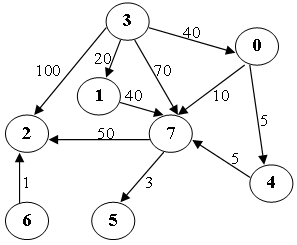Write a program to find the weighted shortest distances from any vertex to a given source vertex in a digraph. If there is more than one minimum path from v to w, a path with the fewest number of edges is chosen. It is guaranteed that all the weights are positive and such a path is unique for any vertex.
Format of functions:
void ShortestDist( MGraph Graph, int dist[], int path[], Vertex S );
where MGraph is defined as the following:
typedef struct GNode *PtrToGNode;
struct GNode{
int Nv;
int Ne;
WeightType G[MaxVertexNum][MaxVertexNum];
};
typedef PtrToGNode MGraph;
The shortest distance from V to the source S is supposed to be stored in dist[V]. If V cannot be reached from S, store -1 instead. If W is the vertex being visited right before V along the shortest path from S to V, then path[V]=W. If V cannot be reached from S, path[V]=-1, and we have path[S]=-1.
Sample program of judge:
#include <stdio.h>
#include <stdlib.h>
typedef enum {false, true} bool;
#define INFINITY 1000000
#define MaxVertexNum 10 /* maximum number of vertices */
typedef int Vertex; /* vertices are numbered from 0 to MaxVertexNum-1 */
typedef int WeightType;
typedef struct GNode *PtrToGNode;
struct GNode{
int Nv;
int Ne;
WeightType G[MaxVertexNum][MaxVertexNum];
};
typedef PtrToGNode MGraph;
MGraph ReadG(); /* details omitted */
void ShortestDist( MGraph Graph, int dist[], int path[], Vertex S );
int main()
{
int dist[MaxVertexNum], path[MaxVertexNum];
Vertex S, V;
MGraph G = ReadG();
scanf("%d", &S);
ShortestDist( G, dist, path, S );
for ( V=0; V<G->Nv; V++ )
printf("%d ", dist[V]);
printf("
");
for ( V=0; V<G->Nv; V++ )
printf("%d ", path[V]);
printf("
");
return 0;
}
/* Your function will be put here */
Sample Input (for the graph shown in the figure):
8 11
0 4 5
0 7 10
1 7 40
3 0 40
3 1 20
3 2 100
3 7 70
4 7 5
6 2 1
7 5 3
7 2 50
3
Sample Output:
40 20 100 0 45 53 -1 50 3 3 3 -1 0 7 -1 0
代码:
#include <stdio.h> #include <stdlib.h> typedef enum {false, true} bool; #define INFINITY 1000000 #define MaxVertexNum 10 /* maximum number of vertices */ typedef int Vertex; /* vertices are numbered from 0 to MaxVertexNum-1 */ typedef int WeightType; typedef struct GNode *PtrToGNode; struct GNode{ int Nv; int Ne; WeightType G[MaxVertexNum][MaxVertexNum]; }; typedef PtrToGNode MGraph; MGraph ReadG() { /* details omitted */ MGraph mg = (MGraph)malloc(sizeof(struct GNode)); int a,b,c; scanf("%d%d",&mg -> Nv,&mg -> Ne); for(int i = 0;i < mg -> Nv;i ++) { for(int j = 0;j < mg -> Nv;j ++) { mg -> G[i][j] = INFINITY; } } for(int i = 0;i < mg -> Ne;i ++) { scanf("%d%d%d",&a,&b,&c); mg -> G[a][b] = c; } return mg; } void ShortestDist( MGraph Graph, int dist[], int path[], Vertex S ); int main() { int dist[MaxVertexNum], path[MaxVertexNum]; Vertex S, V; MGraph G = ReadG(); scanf("%d", &S); ShortestDist( G, dist, path, S ); for ( V=0; V<G->Nv; V++ ) printf("%d ", dist[V]); printf(" "); for ( V=0; V<G->Nv; V++ ) printf("%d ", path[V]); printf(" "); return 0; } /* Your function will be put here */ void ShortestDist( MGraph Graph, int dist[], int path[], Vertex S ) { int vis[MaxVertexNum] = {0},num[MaxVertexNum]; for(int i = 0;i < Graph -> Nv;i ++) { dist[i] = INFINITY; path[i] = -1; } dist[S] = 0; path[S] = -1; num[S] = 1; while(1) { int t = -1,m = INFINITY; for(int i = 0;i < Graph -> Nv;i ++) { if(!vis[i] && m > dist[i]) m = dist[i],t = i; } if(t == -1) break; vis[t] = 1; for(int i = 0;i < Graph -> Nv;i ++) { if(vis[i] || Graph -> G[t][i] == INFINITY) continue; if(dist[t] + Graph -> G[t][i] < dist[i]) { dist[i] = dist[t] + Graph -> G[t][i]; path[i] = t; num[i] = num[t] + 1; } else if(dist[t] + Graph -> G[t][i] == dist[i] && num[i] > num[t] + 1) { num[i] = num[t] + 1; path[i] = t; } } } for(int i = 0;i < Graph -> Nv;i ++) { if(dist[i] == INFINITY) dist[i] = -1; } }
